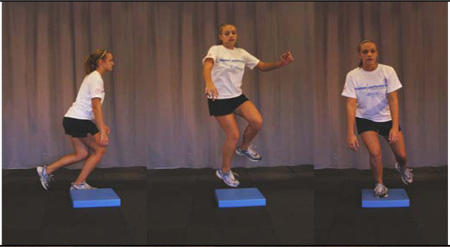Table 12.
Figure 11a–11u, Exercise 10. Single Leg Rotatory Progression
|
Phase I – Single Leg 90° Hop-Hold The starting position for this jump is with the athlete in a semi-crouched position on the single limb being trained. The jump should focus on attaining maximum height while maintaining good form upon landing. During the flight phase, the athlete should rotate 90°. The landing occurs on the same leg and should be performed with deep knee flexion (to 90°). The landing should be held for a minimum of three seconds to be counted as a successful landing. Coach this jump with care to protect the athlete from injury. Start the athlete with a sub maximal effort so she can experience the difficulty of the jump. Continue to increase the intensity of the jump as the athlete improves her ability to stick and hold the final landing. Have the athlete keep her focus away from her feet, to help prevent too much forward lean. |
 |
|
Phase II – Single Leg 90° AIREX Hop-Hold The starting position for this jump is with the athlete in a semi-crouched position on the single limb being trained. The jump should focus on attaining maximum height while maintaining good form upon landing. During the flight phase the athlete should rotate 90°. The landing occurs on the same leg and should be performed with deep knee flexion (to 90°). The landing should be held for a minimum of three seconds on an AIREX pad to be counted as a successful landing. Coach this jump with care to protect the athlete from injury. |
 |
|
Phase III – Single Leg 90° Hop-Hold Reaction Ball Catch The starting position for this jump is with the athlete in a semi-crouched position on the single limb being trained. The jump should focus on attaining maximum height while maintaining good form upon landing. During the flight phase the athlete should rotate 90°. The landing occurs on the same leg and should be performed with deep knee flexion (to 90°). The landing should be held for a minimum of three seconds on an AIREX pad to be counted as a successful landing. Upon landing a ball will be passed back and forth with the athlete to increase the difficulty of a successful landing. |
 |
|
Phase IV – Single Leg 180° AIREX Hop-Hold The starting position for this jump is with the athlete in a semi-crouched position on the single limb being trained. The jump should focus on attaining maximum height while maintaining good form upon landing. During the flight phase the athlete should rotate 180°. The landing occurs on the same leg and should be performed with deep knee flexion (to 90°). The landing should be held for a minimum of three seconds on an AIREX pad to be counted as a successful landing. |
 |
|
Phase V – Single Leg 180° AIREX Hop-Hold Reaction Ball Catch The starting position for this jump is with the athlete in a semi-crouched position on the single limb being trained. The jump should focus on attaining maximum height while maintaining good form upon landing. During the flight phase the athlete should rotate 180°. The landing occurs on the same leg and should be performed with deep knee flexion (to 90°). The landing should be held for a minimum of three seconds on an AIREX pad to be counted as a successful landing. Upon landing a ball will be passed back and forth with the athlete to increase the difficulty of a successful landing. |
 |
